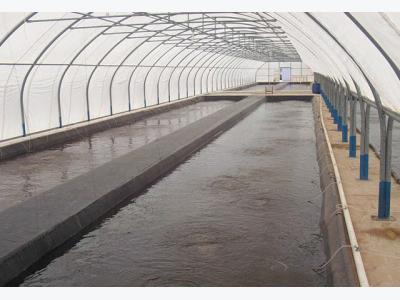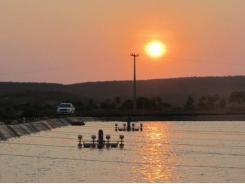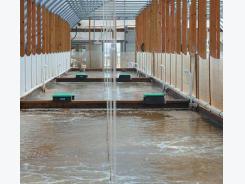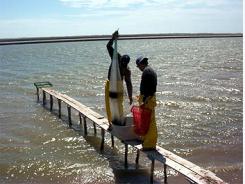New nursery diet for shrimp performs well at super-high stocking densities

Interest has renewedin multiphase shrimp production, where shrimp postlarvae (PL) are stocked in intensive raceway tanks during a short nursery phase before stocking in growout ponds. In reporting the results of the Global Shrimp OP: 2001 survey on shrimp nurseries, Harvey Persyn and Randall Aungst said the main advantages expressed for using nurseries were to shorten the production cycle in the hatchery and on the farm, regulate the flow of PL from hatchery to farm, and improve pond survival by stocking older, more robust PL. Several studies have confirmed that a 15% or higher improvement in pond survival is generally obtained by implementing a nursery phase.
In Asia, shrimp culture is characterized by a high degree of specialization. Some nursery operations are specialized in rearing PL to desired sizes, which delays exposure to potential pathogens in ponds. Additionally, PL held in nursery tanks generally show more advanced gill development, which is important for acclimation to farm conditions.
In the Americas, nurseries are mostly used in intensively managed production systems for better facility utilization and biosecurity. In temperate climates, indoor raceway systems head start seedstock in the spring and allow the production of 2 shrimp crops/year.
Nursery Feeding Practices
The greatest operational expense in nurseries is the initial cost of the PL, so their survival rate is critical to profitability. According to Wickins and Lee (2002), at least 50- 70% survival is required. This, however, can only be obtained with careful management and optimal feeding practices.
In the 2001 GAA survey, participants in Asia and the Americas most frequently fed Artemia nauplii and biomass, and formulated nursery diets. Some hatchery operators continued feeding algae during the nursery phase, because apart from being of nutritional value, it helps in coping with nitrogenous wastes at high stocking densities and high feeding rates.
Testing at High Stocking Densities
Recently, a complete raceway diet developed by INVE Technologies NV was tested in the high-density culture of Pacific whiteleg shrimp, Litopenaeus vannamei. Diet RW+, with 48% protein and 13% fat, was fed to shrimp in 500-l tanks with 4 replicates/treatment. Table 1 shows the composition of RW+.
Table 1. Composition of raceway diet RW+.

In the first two-week trial, the RW+ diet was compared to shellfree Artemia (dehydrated, decapsulated Artemia cysts), an acclimation diet (AD) with 40% protein and 13% fat, and a commercial diet (Com1) with 50% protein and 10% fat. Every diet was fed at 100% of the feeding regime.

Figure 1. Trial 1: Survival and dry weight gain of L. vannamei PL stocked at high densities and fed different diets over two weeks. Mean values of four replicates and standard deviation bars.

Figure 2. Trial 2: Survival and dry weight gain of PL stocked at super-high densities and fed different diets over three weeks. Mean values of four replicates and standard deviation bars.
Animals at stage PL10 were stocked at high density (25,000/ m2) and harvested at PL25. The diets were administered in six daily rations for total feeding rates that gradually increased from 35 g/mt/day to 75 g/mt/day. Water temperatures during the trial averaged 26° C.
In a second trial of three weeks, RW+ was compared to the shellfree Artemia, an experimental diet (Exp) with 38% protein and 8% fat, and a commercial raceway diet (Com2) with 53% protein and 16% fat. Animals were stocked in stage PL10 at a super-high density (45,000/m2) and harvested at PL30. Feeding rates increased from 45 g/mt/day for PL10 to 120 g/mt/day for PL30. Water temperature was maintained at 28° C. Daily water exchange rates up to 50% were applied in both trials to avoid water quality problems.
Artemia Performance
The shellfree Artemia sink fast and have a particle size of 250 μm, and thus are not suitable for mysis stages. However, they are an excellent feed for benthic PL and can be used for partial or total replacement of Artemia nauplii. The shellfree Artemia, which are actually Artemia embryos with 30-50% more energy than newly hatched nauplii, are potentially more nutritious for feeding. Survival rates of the test treatments fed the Artemia were 89% in trial 1 and 98% in trial 2 (Figures 1 and 2).
The good performance of the Artemia product was related to the retention of its nutritional value after rehydration in water. It leached very low levels of soluble protein and carbohydrates in comparison to the artificial diets. However, as confirmed by the results of trial 2, growth was generally only moderately good, probably due to the relatively low levels of essential n-3 fatty acids in the cysts.

Figure 3. Total biomass yield obtained in trial 2. Mean values of four replicates.
Raceway Diet Results
The performance of RW+ was generally up to the standard of the Artemia product. In trial 1, survival and growth rates were similar with both. In trial 2, survival with RW+ was lower than with Artemia, but growth rate was higher. In any case, survival rates with RW+ were considerably higher than typical critical levels for profitability. The final yielded biomass of 1.7 kg/mt (Figure 3) was similar with both RW+ and the shellfree Artemia.
In comparison to treatments Com1 and Com2, RW+ provided similar or higher survival rates and significantly higher growth rates. As such, the nursed juveniles reared with RW+ were larger than the animals from the other treatments. The total yielded biomass measured in trial 2 with RW+ was twice that of the Com2 diet. The good performance of RW+ at super-high stocking density was exceptionally rewarding. Normally, nursery tanks are stocked at 500- 5,000 PL/m2 to obtain acceptable growth rates.
Acclimation Diet
The acclimation diet was a supplement for shrimp PL used to increase the stress resistance of the animals just before and during their transfer to growout ponds. Designed to partially replace artificial diets and provide a boost of immunostimulants and vitamins, the supplemental diet does not sustain optimal growth when fed at 100% of the feeding regime. This was confirmed by the moderate growth rate obtained with this product in trial 1.
Conclusion
In trials, a newly developed stand-alone raceway diet designed for use in semi-intensive, intensive, or super-intensive raceway systems was the first dry nursery diet shown to ensure good performance at stocking densities up to 45,000/m2. In reducing costs and improving the operating efficiency of shrimp hatcheries, its development is an important step in the successful implementation of the nursery phase of shrimp production while meeting the expectations of shrimp growers willing to pay higher prices for large, robust nursed juveniles that perform well in growout.
Authors:
Roeland Wouters, Ph.D. - r.wouters@inve.be
Tille Van Horenbeeck, M.Sc. - INVE Technologies NV - Hoogveld 93 - B-9200 Dendermonde, Belgium
Note: Cited references are available from the authors.
Related news
Tools

Phối trộn thức ăn chăn nuôi

Pha dung dịch thủy canh

Định mức cho tôm ăn

Phối trộn phân bón NPK

Xác định tỷ lệ tôm sống

Chuyển đổi đơn vị phân bón

Xác định công suất sục khí

Chuyển đổi đơn vị tôm

Tính diện tích nhà kính

Tính thể tích ao



 Mixed Maturation Diets Improve Shrimp Broodstock Performance
Mixed Maturation Diets Improve Shrimp Broodstock Performance  New technology proves effective for EMS-hit shrimp farmer
New technology proves effective for EMS-hit shrimp farmer